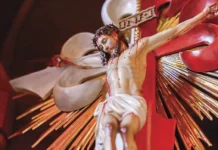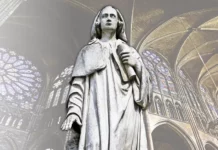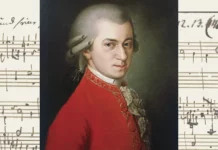The Grand Organ of Notre-Dame Cathedral embellished ceremonies in the days of glory, remained standing through the Revolution and even survived the flames that devastated the sacred structure. Is its story not a sign of God’s love for the firstborn daughter of the Church?
The human voice has an extraordinary capacity to express inner dispositions. The thunderous roar of a military general transmits the strength and courage that characterize a good commander and instils courage in the soldiers that follow him. In contrast, a mother’s manner of speaking, whether in correcting or caressing her child, reveals the torrents of affection that emanate from her heart.
Imagine the expressive capacity of someone who had more than a hundred registers to express the most varied imponderables that fill the spirit, with specific nuances representing each state of soul?
The Holy Spirit, in His desire to bring men closer to celestial realities, inspired human ingenuity to create a musical instrument capable of imparting resonance to the rich and nuanced voice of the Holy Church. Containing within itself diverse timbres that allow endless harmonies and combinations of sounds, the organ has the power to express, here on earth, the melodies of Paradise.
How was this instrument born? When was it incorporated into liturgical celebrations?
How the liturgical the use of the organ began
In the early days of the Church, the use of musical instruments in the Liturgy was regarded with reserve because of their association with profane or idolatrous events, and the same was true of the organ.
However, in the seventh century Pope Vitalian authorized the use of this instrument in religious ceremonies, and in the year 757, Emperor Constantine V marked a turning point in events when he sent a primitive organ to King Pepin the Short. The gift of the Byzantine monarch was installed in the chapel dedicated to St. Cornelius in Compiègne, belonging to the King of the Franks and Charlemagne’s father, and was duly noted by the Carolingian chroniclers.
By the following century the presence of organs was already common in Catholic churches and monasteries.1 And, over time, this instrument became the natural accompaniment for liturgical chant. All cathedrals and churches of a certain size were sure to have at least one.
Today, in the lack of time or resources to install such complex instruments, electronic keyboards are used to recreate as faithfully as possible the timbre and ambience produced by the traditional pipe organ.

The “sum of the ages” applied to an instrument
In human development a curious phenomenon occurs, which Dr. Plinio Corrêa de Oliveira called the “sum of the ages”.2 Each phase of human life has its own characteristics. When people develop in harmony with innocence, they do not lose the good aspects of their previous age, but these qualities are added to the next stage. Thus, with the passing of the years they accumulate a storehouse of knowledge and virtues that definitively mark their personality and make them capable of transmitting the fruit of that spiritual maturity to others.
Dr. Plinio’s expression may be applied, mutatis mutandis, to one of the largest and most famous organs of Christianity, considered “the most important in France and undoubtedly the most famous in the world”3: that of Notre-Dame Cathedral in Paris.
Over the centuries, it was perfected and expanded without losing any of its earlier qualities, until reaching a high peak in the fulfilment of its mission: to embellish liturgical ceremonies and to help portray the supernatural reality within the cathedral.
Centuries of gradual improvement
The beginning of this Grand Organ’s life traces back to the 15th century. The canons, making use of a generous donation from the Duke of Berry, commissioned the manufacturer Frédéric Schambantz to build a new organ to replace the existing one from the 13th century, deemed too small to meet the needs of the majestic cathedral.
On October 25, 1403, its installation was complete, mounted on a stone platform in a loft above the great western portal. It comprised approximately six hundred pipes, as well as a keyboard with forty-six notes and a foot pedal.
The duties of the new organist, Henri de Saxe, were clearly defined: to ensure the preservation of the instrument and to play at twenty-three feasts during the year, in addition to performing at some exceptional events, such as the coronation of King Henry VI, held at Notre Dame in 1431.
In 1415 the first repairs began, which consisted of cleaning, checking and tuning the instrument. Often, such maintenance was combined with minor modifications by the organ specialist summoned for this purpose, such as those carried out by Jean Robelin in 1463, and Nicolas Dabenet in 1564.
At the beginning of the 17th century, the emergence of the Flemish organ, which boasted two separate keyboards and registers, made its medieval counterpart an archaic instrument. For this reason, Valéran de Héman added a new console to the organ of Notre-Dame, which doubled its capabilities. In 1610, thus renewed, it was entrusted to the new titular organist, Charles Thibault.
In later reforms, executed mainly by Héman himself and Alexander Thierry, the king’s organ maker, the Grand Organ of Notre-Dame was enlarged to three and four keyboards, the first of which, still dating from the medieval period, was enriched with new registers.
The winds of the Enlightenment blow over Paris
In the 18th century, when Paris was under the spell of a new philosophy, the Cathedral’s architecture underwent significant changes aimed at adapting it to the winds of the time.
“France had entered the age of enlightenment. The cathedral choir was remade in the baroque style. The arches of the main nave were hidden with large paintings – the ‘Mays’ – offered each year by the goldsmiths’ guild. The chapter is quick to replace the stained-glass windows on the upper part of the main nave by windows with white rhombuses. Even the least reminders of the medieval style were to disappear.”4
In this context, the new titular organist, Antoine Calvière, arranged the complete reconstruction of the instrument, entrusted to the famous François Thierry. The latter installed a large wooden case in the Louis XV style then in vogue, hiding part of the rose window, and the loft was closed by a wrought-iron balustrade with gold ornaments. In 1733 François Thierry’s organ had five keyboards with fifty notes and forty-seven registers, and was long considered the most complete classic French organ.
Fifty years later, the organ-maker François-Henri Clicquot was called upon to work on the instrument, which had deteriorated considerably. Clicquot undertook a general expansion: he widened the sideboard, expanded the number of registers and added a positif de dos.5
This comprehensive remodelling was completed on May 5, 1788.
Threatened by the Revolution, but not destroyed
During the French Revolution, the Grand Organ faced the risk of being destroyed or sold, but Divine Providence, pleased by its heavenly harmonies, ordained that this important element of the historical and symbolic heritage of the firstborn daughter of the Church be spared.

photographed at the beginning of the 20th century
The Cathedral of Notre-Dame was desecrated and transformed into a “temple of reason”, but the great instrument remained standing. Only a few ornaments reminiscent of the monarchy and the fleur-des-lis at the base of the case’s columns were removed by axe blows.
In 1794, citizen Godinot summoned some organists to play the instrument in order to prevent its deterioration, and one of them, citizen Desprezes, commented: “The combination of the registers produces different effects, each one more beautiful than the other, forming an orchestra that could serve well to accompany the civic chants, kindling the hearts of true republicans, as well as stirring up the wrath that we hold for tyrants.”6 Incredible as it may seem, this speech momentarily saved the instrument from revolutionary attacks…
In March 1795, a new threat hovered over it. The National Convention demanded the sale of existing organs in the churches that belonged to the Republic and in August of the same year the Grand Organ of Notre-Dame was examined for this purpose by the temporary commission of arts. However, the latter included it in the category of those that should be preserved due to their great importance.
In the simplicity of these episodes, the hand of Providence can clearly be seen protecting one of its beloved earthly treasures.
Renovation of Viollet-le-Duc and Cavaillé-Coll
Having resisted the storm of the French Revolution, the history of the Grand Organ now continues its journey through the period of Romanticism.
In 1847, when Eugène Viollet-le-Duc7 began work on the cathedral’s restoration, Eugène Sergent was appointed titular organist. At this juncture, however, the dust in the pipes, the wear and tear of the mechanism, the faulty air intake, and the rain and the wind entering through the windows had rendered the valuable instrument unusable.
At the request of Viollet-le-Duc, Aristide Cavaillé-Coll made a general assessment of its condition in 1860. And since the expenditure on the architectural work absorbed almost the entire amount available, Viollet-le-Duc asked him to restore it using as much of the existing material as possible. The desired outcome was an instrument worthy of a cathedral, but without superfluities.
After Viollet-le-Duc had rejected his original project, which included the preservation of the positif de dos casing, Cavaillé-Coll designed a “revolutionary organ”8 which involved a complete makeover of the internal arrangement of the instrument in accord with his own conception.
The Grand Organ of Notre-Dame now had eighty-six registers, divided into five keyboards of fifty-six notes and a pedal of thirty notes. The work was finished in December 1867, allowing the organ to be played on Christmas Eve, but its inauguration only took place on March 6, 1868.
On that occasion, Archbishop Georges Darboy of Paris blessed the new instrument, while a member of the choir sprinkled it with holy water from the top of the tribune. Several renowned organists were present.
Configuration of the contemporary organ
A restoration completed in 1992 incorporated electronic elements into the Grand Organ. It was blessed by Cardinal Jean-Marie Lustigier, Archbishop of Paris, and inaugurated in December. A series of concerts was then organized, which were attended by fifty thousand people in one week!
The additions that modernized Notre Dame’s “voice” did not diminish its nobility and originality. The blessings that marked centuries of ceremonies filled with tradition so pervaded it that its pipes, now mechanized and computerized, continued to reverberate with their almost angelic sound inside the historic cathedral.
Finally, in 2012, to celebrate the Jubilee of Notre-Dame de Paris, on its 850th anniversary, the organ underwent a renovation of its transmission system and a general cleaning of its 7,952 pipes – over ten times the number with which it was originally built.

Sign of predilection for the firstborn daughter of the Church
The Grand Organ of Notre-Dame is an essential piece in the liturgical life of the famous cathedral. Witness to centuries of history, an outstanding element of the religious and cultural heritage of the French people, it was spared by Providence from the catastrophes that the cathedral itself had to suffer. And not even the flames of the fire that recently devastated the cathedral affected the organ’s structure.
Is this preservation not a sign of God’s predilection for France, the firstborn daughter of the Church, for which it serves, so to speak, as a grandiose and expressive voice?
Time will tell. But one thing is certain: even if at certain moments the Church seems to be struck by the worst catastrophes, she can never be slain, defeated or even silenced. At the hour when it is least expected, her voice resurges gloriously, crying out the Truth from the four corners of the earth. ◊
Notes
1 Cf. RIGHETTI, Mario. Manuale di Storia Liturgica. 3.ed. Milano: Àncora, 2005, v.I, p.695.
2 Cf. CLÁ DIAS, EP, João Scognamiglio. O dom de sabedoria na mente, vida e obra de Plinio Corrêa de Oliveira [The Gift of Wisdom in the Mind, Life and Work of Plinio Corrêa de Oliveira]. Cittá del Vaticano-São Paulo: LEV; Lumen Sapientiæ, 2016, v.V, p.18-19.
3 LEFEBVRE, Philippe. Les orgues. In: VINGT-TROIS, André (Dir.). La grâce d’une cathédrale. Notre-Dame de Paris. Strasbourg-Paris: La Nuée Bleue; Place des Victoires, 2012, p.449. The historical facts concerning the Grand Organ contained in this article were taken from this work.
4 LEFEBVRE, op. cit., p.451.
5 Literally: “Back positive”. It is a replica, in smaller dimensions, of the main registers of the grand organ which, in the baroque period, was a separate instrument strapped to the organist’s back. Today it is activated by the main keyboard.
6 Idem, p.452.
7 Eugène Viollet-le-Duc (1814-1879), French architect, restorer and historian from the 19th century, especially dedicated to medieval architecture. He renovated numerous buildings in France, becoming especially renowned for his work on Notre-Dame Cathedral of Paris, where, together with Jean-Baptiste-Antoine Lassus, he sought to restore the original style of the church with the greatest possible fidelity.
8 LEFEBVRE, op. cit., p.453.







